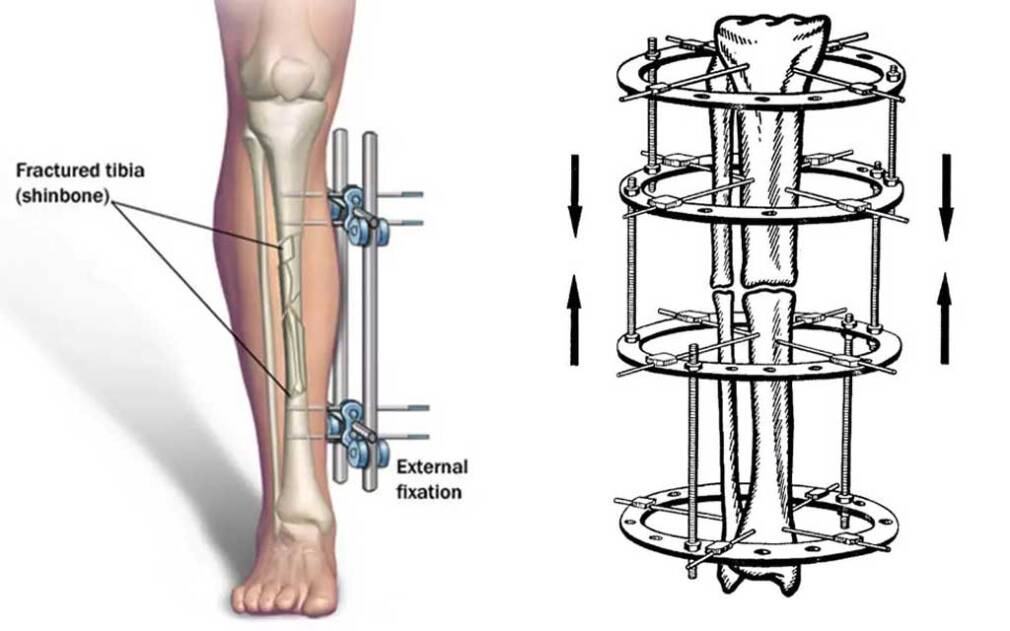External fixation plays a crucial role in limb lengthening and bone healing, providing a stable framework to support the bone as it grows and regenerates. This method involves using an external fixation device, which consists of metal pins and wires connected to an external frame. The device helps stabilize the bone, allowing for controlled lengthening and proper fracture healing.Unlike internal fixation methods, external fixators remain outside the body, making adjustments easier during the healing process. They are commonly used in orthopedic surgeries, particularly for patients requiring distraction osteogenesis, where bones are gradually lengthened. In this guide, we’ll explore how external fixation works, its benefits, and how it compares to internal fixation techniques.
Table of Contents
ToggleWhat is an External Fixation Device?
An external fixation device is a medical apparatus used to stabilize fractured or lengthened bones. It consists of metal pins or wires inserted into the bone, which are then connected to an external frame. This structure keeps the bone aligned while allowing gradual adjustments during the healing or lengthening process.External fixation is commonly used in cases of bone lengthening, complex fractures, and limb deformity corrections. One major advantage of an external fixator is that it allows surgeons to make real-time modifications without additional surgery. Patients can continue daily activities while the bone heals, although careful post-operative care is essential to prevent complications.
How Does External Fixation Device Work?
The external fixation device functions by securing the bone externally with metal pins, which penetrate the skin and anchor into the bone. The external frame holds the bone in place, providing stability for fracture healing and lengthening procedures.In limb lengthening, the bone is surgically cut, and the external fixator gradually pulls the two bone ends apart. This process, known as distraction osteogenesis, stimulates new bone growth in the gap, leading to increased bone length over time. The device allows precise control over the bone lengthening process, ensuring a gradual and safe increase in limb length.
External Fixation vs Internal Fixation: Which One is Better for Limb Lengthening?
Both external fixation and internal fixation are effective methods for stabilizing and lengthening bones. However, each has its own advantages and considerations depending on the patient’s condition and treatment goals.
Differences Between External and Internal Fixation
External Fixation:
- Uses an external frame to stabilize the bone
- Requires metal pins inserted through the skin into the bone
- Allows gradual bone adjustments without additional surgery
- Suitable for complex fractures, limb lengthening, and deformity correction
Internal Fixation:
- Uses metal rods, screws, or plates placed inside the body
- Provides internal stability without an external frame
- More discreet but requires additional surgery for removal if needed
- Commonly used for fractures and bone reconstructions
In limb lengthening, external fixation is often preferred due to its adjustability, while internal fixation may be used for final stabilization after lengthening is complete.
Open Reduction External Fixation
Open reduction external fixation is a surgical technique used to stabilize severe fractures and bone deformities. Unlike closed reduction, which realigns bones without surgery, open reduction involves surgically exposing the bone to achieve proper alignment before applying an external fixator.
How Open Reduction External Fixation Works in Surgery
- Surgical Incision – The surgeon makes an incision to access the fractured or deformed bone.
- Bone Realignment – The bone is carefully repositioned for optimal healing.
- Fixator Application – Metal pins are inserted into the bone and connected to an external fixator frame.
- Gradual Adjustment – The frame allows controlled movements for bone healing and possible lengthening.
Benefits of Open Reduction External Fixation
- Provides excellent stability for complex fractures
- Enables real-time adjustments without repeated surgeries
- Supports fracture healing while maintaining mobility
- Minimizes soft tissue damage compared to internal fixation
This method is particularly useful for severe fractures, non-unions, and cases requiring both stabilization and bone lengthening.
The Role of Fixator Muscle in External Fixation
During external fixation, surrounding muscles play a critical role in supporting bone stability and mobility. The fixator muscle refers to the muscle groups that help maintain joint stability while the bone is healing or lengthening.Muscle adaptation is crucial in limb lengthening procedures, as prolonged use of an external fixator can lead to stiffness and muscle tightness. Regular physical therapy is essential to maintain muscle flexibility and strength, preventing complications such as joint contractures.
External Fixator for Ankle Injuries and Bone Lengthening
An external fixator ankle device is commonly used to stabilize severe ankle fractures and correct deformities. Ankle injuries can be challenging to treat, especially when bone fragments are displaced or when traditional casting is insufficient.Using an external fixator, surgeons can ensure precise alignment of the bones, promoting effective bone healing. Additionally, in cases of limb lengthening, external fixation is used to gradually extend the tibia or fibula, correcting leg length discrepancies.
Bone Healing and Fracture Healing with External Fixation
The external fixation device plays a vital role in bone healing by stabilizing the fracture site and allowing controlled movement. The healing process typically follows these stages:
- Inflammation Phase – The body forms a blood clot around the fracture.
- Soft Callus Formation – New tissue begins to bridge the fractured bone ends.
- Hard Callus Formation – The soft tissue hardens into new bone.
- Bone Remodeling – The bone strengthens and regains its normal structure.
By keeping the fractured bone stable and aligned, external fixation enhances fracture healing, reducing the risk of complications.
Ilizarov External Fixator
The Ilizarov external fixator is a specialized device used for limb lengthening, complex fractures, and deformity corrections. Developed by Dr. Gavriil Ilizarov, this circular fixator allows controlled distraction osteogenesis, where bone growth is stimulated through gradual separation.The Ilizarov external fixator is highly effective in treating limb length discrepancies, bone infections, and severe deformities, making it a widely used technique in orthopedic surgery.
Distraction Osteogenesis
Distraction osteogenesis is the biological process that enables bone lengthening through gradual stretching. This technique is commonly performed using an external fixation device, where controlled mechanical tension stimulates new bone formation.
The process involves three phases:
- Latent Phase – The bone is surgically cut, and healing begins.
- Distraction Phase – The external fixator slowly separates the bone ends, promoting new bone growth.
- Consolidation Phase – The new bone hardens, completing the lengthening process.
This method is widely used for treating limb length discrepancies and congenital deformities.
Is External Fixation the Right Choice for You?
Choosing external fixation for limb lengthening or fracture healing depends on various factors, including the severity of the condition and treatment goals. While external fixators offer precise adjustments and effective bone healing, they require diligent care and a longer recovery period.If you are considering limb lengthening or need treatment for a complex fracture, consult with an orthopedic specialist to determine the best approach. External fixation remains a highly effective method for achieving successful bone regeneration and improved mobility.


